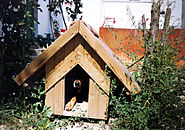-
About
- About Listly
- Community & Support
- Howto
- Chrome Extension
- Bookmarklet
- WordPress Plugin
- Listly Premium
- Privacy
- Terms
- DMCA Copyright
- © 2010-2025 Boomy Labs


 rhayeshi
rhayeshi
Listly by rhayeshi
Winter affects your dog in the same way it affects you. Making sure your dog's sleeping area stays warm during winter nights is therefore absolutely critical. If you fail to do so, your dog could develop painful frostbite that could lead to amputations[1] or severe hypothermia or abnormally low body temperature [2] that can put your dog in a coma which can end up killing your pet. What do you need to know to keep your dog warm in winter especially at night? Here are 12 things to get you started. Add anything else important missing from the list.
It is a good idea to locate your pet's shelter in a larger enclosed area such as a garage, that will provide additional protection from the winter cold. Moving your dog's kennel to an enclosed space is especially necessary when temperatures fall to below 40 degrees F or 5 degrees C. As mentioned before, however, because rooms like garages have no temperature control, you could install a light bulb above the kennel for extra warmth.[1]
Dogs that sleep outside may go unsupervised for longer periods during winter nights, leading to boredom and restlessness. You might then find that your pet has attacked his beddings. As such, you need to settle for beddings made of fabric that is harder for your dog to destroy such as microfiber or fleece. You should avoid blankets with large or loose threading.[1]
Bearing in mind that dark colors absorb while light colors reflect heat, your dog's kennel needs to be built for both cold and hot weather. A dark-colored kennel will be warm in winter but too hot in summer, while a light-colored one will be cool in summer but freezing in winter. Experts suggest picking colors like green for your dog house because they offer the best of both worlds. Another good tip is using a roof that is dark on one side and light on the other which you can flip over when seasons change from hot to cold and vice-versa.[1]
A nesting box is where your dog's bedding will go[1] so it's a good idea to make sure the box is raised off the ground during winter. In addition, placing a soft plush bed mat on the floor of the nesting box will provide your dog with extra warmth and comfort.

Facing your dog's kennel door east or south should keep it safe from cold winter winds. Avoid centralizing the kennel door, however, to give him a protected corner space where you can position a waterproof bed for your dog to use when seeking refuge from harsh weather. [1] You also need to cover the dog house entrance with a baffle or canvas flap in addition to extending the roofline over it, [1] to ensure he stays warm in winter.
Your dog's coating, size, weight, age, and health determine what temperature she prefers in your home. Furry and heavier dogs handle cold better while puppies, smaller, older and sickly dogs need warmer sleeping areas. In addition to a soft warm bed, home heating specialists recommend maintaining a home temperature of between 69 and 72 degrees F or 20 and 22 degrees C in winter.[1]
Dogs can be just as picky about bedding materials as their two-legged masters. They often prefer linens that feel good so you need to choose soft dog beds or mats that feel good and keep them warm at the same time.[1]
Dogs frequently end up in our beds because they smell better than their own beds.[1] You, therefore, need to buy your dog a warm plush bed that you can clean easily to keep it fresh through the winter when your dog will be spending more time on it.
Feeling cold makes your dog that likely already feels lonely sleeping alone, want a companion, even more, to help stay warm.[1] A stuffed plush toy that your dog can cuddle with can serve both purposes - keeping your dog company and helping her to stay warm.
Just like us, dogs find bare, uncarpeted floors cold in winter. Our canine family members have a difficult time sleeping on exposed hardwood, tile, and linoleum floors which get really cold in winter. To help your dog stay warm, experts recommend raising your dog's sleeping area around 3 inches off the floor.[1] If your dog sleeps on the floor, winter dog bed mats are a good option for insulating her against cold bare floors.

To ensure your dog stays warm through winter nights, avoid placing her bed in drafty areas of your home such as near windows, doors, vents, and fans. Furthermore, move your dog's bed if it's in your garage, basement or laundry room. Leaving it there would not be wise because you can't control the temperature in those rooms.[1] After you work out the best location for your dog's bed, you can get your dog a soft plush bed to ensure your dog keeps warm at night. You can, however, move the bed in the daytime next to a window that lets in light so your dog can sunbathe.[2]
Dogs that sleep outside stay warm by generating body heat which needs to be trapped in the dog house to ensure the dog stay warm. If your dog's kennel is too big, it will allow his body heat to escape easily, severely punishing your dog during cold spells. The dog house should have just enough space for your pet to sit, turn around and lie down.[1]
